The 1988 BMW 7 Series, a symbol of opulence and engineering prowess, marked a pivotal moment in the German automaker’s history. This generation of the flagship sedan introduced a bold new design language, advanced technology, and a level of refinement that set the benchmark for luxury cars in the late 1980s.
The 7 Series was more than just a vehicle; it was a statement of success, a testament to the meticulous craftsmanship that BMW was known for.
Beyond its aesthetic appeal, the 1988 7 Series boasted a range of powerful engine options, including a potent 3.4-liter inline-six and a formidable 5.0-liter V12, both delivering a blend of smooth power and exhilarating performance. The car’s handling was equally impressive, thanks to its sophisticated suspension and precise steering, making it a joy to drive on both winding roads and open highways.
Overview

The 1988 BMW 7 Series, internally designated as the E32, marked a significant departure for the luxury carmaker. It was the first generation of the 7 Series to feature a completely redesigned platform, offering a blend of advanced technology, luxurious amenities, and improved performance compared to its predecessors.
This model solidified BMW’s position as a leading manufacturer of premium sedans and set the stage for future generations of the 7 Series.
Key Features and Specifications
The 1988 BMW 7 Series introduced several innovative features that redefined luxury car standards. Here are some key features and specifications of the E32:
- Engines:The 1988 7 Series offered a range of powerful engines, including a 3.0-liter inline-six, a 3.4-liter inline-six, and a 5.0-liter V12. The V12 engine, available in the 750iL model, was a technological marvel, delivering exceptional performance and smoothness.
- Transmission:The E32 featured a four-speed automatic transmission, which provided smooth gear changes and efficient power delivery.
- Suspension:The 7 Series boasted a sophisticated independent suspension system that provided a comfortable ride while maintaining precise handling.
- Interior:The interior of the E32 was designed to provide a luxurious and comfortable environment for passengers. It featured premium leather upholstery, wood trim, and advanced features like automatic climate control and power seats.
- Safety:The 1988 7 Series emphasized safety with features like anti-lock brakes (ABS), driver and passenger airbags, and a reinforced passenger cabin.
Significance in BMW’s History
The 1988 BMW 7 Series was a pivotal moment in the company’s history. It represented a shift towards a more modern and technologically advanced approach to luxury car manufacturing. The E32 introduced several innovations that became hallmarks of future BMW models, including:
- Advanced Technology:The E32 incorporated features like a digital instrument cluster, a central control unit for various functions, and a rear-view camera, demonstrating BMW’s commitment to technological advancement in the luxury segment.
- Enhanced Performance:The 7 Series’ powerful engines and sophisticated suspension system offered a blend of comfort and performance that set a new benchmark in the luxury car market.
- Sophisticated Design:The E32’s design, with its clean lines and distinctive styling elements, reflected a modern and elegant approach to luxury car design.
- Increased Market Presence:The success of the 1988 7 Series helped to solidify BMW’s position as a leading manufacturer of luxury cars and expanded the company’s market presence globally.
The 1988 BMW 7 Series, therefore, played a significant role in shaping the company’s identity and establishing its reputation for producing technologically advanced, luxurious, and performance-oriented vehicles.
Design and Styling: 1988 BMW 7 Series
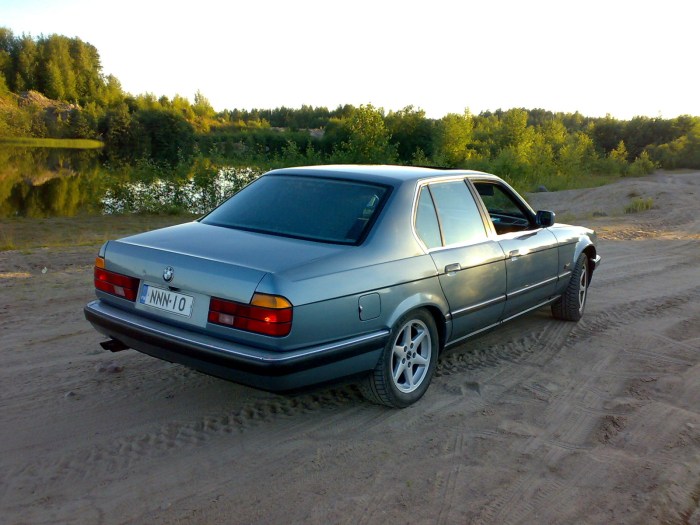
The 1988 BMW 7 Series, the E32 generation, marked a significant shift in the brand’s design philosophy, introducing a more aerodynamic and modern aesthetic. This generation was characterized by its clean lines, sharp angles, and a distinctive grille that would become synonymous with BMW’s flagship sedan.
Exterior Design
The 1988 7 Series boasted a sleek and sophisticated exterior design that was a departure from the more boxy and conservative styling of its predecessors. Its aerodynamic shape was achieved through a low-slung profile, a sloping hood, and a streamlined rear end.
The front end featured the iconic BMW kidney grille, which was larger and more prominent than previous models. The grille was flanked by rectangular headlights that incorporated a distinctive eyebrow-shaped design element. The side profile was characterized by sharp creases and a prominent character line that ran from the front fender to the taillights.
The rear end featured a wide, horizontal taillight design and a large rear bumper with integrated reflectors.
Interior Design
The interior of the 1988 7 Series was a testament to luxury and craftsmanship. It featured high-quality materials, including leather upholstery, wood trim, and brushed aluminum accents. The dashboard was ergonomically designed and featured a driver-focused layout with clear instrumentation and controls.
The seats were supportive and comfortable, offering ample legroom and headroom for both front and rear passengers. The 7 Series was equipped with a range of advanced features, including power windows, power seats, automatic climate control, and an optional sunroof.
The 1988 BMW 7 Series, known for its luxurious appointments and powerful engines, offered a range of models to suit different needs. For those seeking a sportier experience, BMW offered the 735i, which featured a powerful 3.5-liter inline-six engine. However, for drivers seeking a true grand touring experience, the 1988 BMW 635Csi offered a compelling alternative.
The 635Csi, with its sleek coupe body and powerful 3.5-liter inline-six engine, provided a thrilling driving experience while still offering the luxury and refinement expected from a BMW. Ultimately, the 1988 BMW 7 Series offered a diverse range of choices, catering to both those who valued comfort and those who craved performance.
Styling Compared to Other Luxury Cars
The 1988 BMW 7 Series was positioned as a direct competitor to other luxury sedans of the time, including the Mercedes-Benz S-Class and the Cadillac Fleetwood. Compared to these rivals, the 7 Series offered a more modern and athletic design.
Its aerodynamic shape and sharp lines contrasted with the more traditional and conservative styling of the S-Class and Fleetwood. The 7 Series’s interior also stood out for its high-quality materials and driver-focused design, offering a more sophisticated and luxurious experience than its competitors.
Performance and Handling
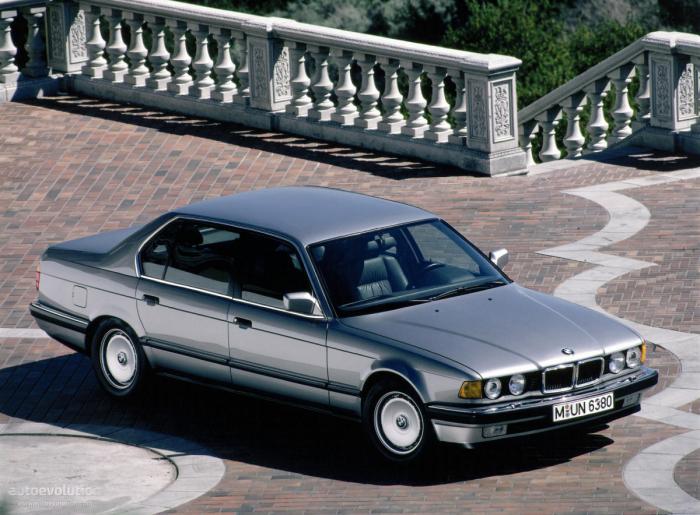
The 1988 BMW 7 Series was a luxurious sedan that offered a range of powerful engine options and a refined driving experience. The car’s performance characteristics and handling capabilities were a testament to BMW’s engineering prowess, delivering a blend of power, agility, and comfort that was unmatched in its class.
The 1988 BMW 7 Series, known for its luxurious appointments and advanced technology for its time, was a significant departure from the brand’s previous offerings. While it carried the traditional BMW hallmarks of performance and handling, it also introduced features like a digital instrument cluster and an optional rear-seat entertainment system.
This focus on luxury and technology continued to evolve in subsequent generations, culminating in the 2004 BMW 330Ci , a sporty coupe that offered a more accessible taste of the brand’s refined sensibilities. The 1988 7 Series, however, remains a significant milestone in BMW’s history, marking a turning point towards the brand’s modern focus on both performance and opulence.
Engine Options
The 1988 7 Series was available with a variety of engine options, each offering a unique blend of power and efficiency. The engine lineup included:
- 735i:This model was powered by a 3.4-liter inline-six engine that produced 208 horsepower. This engine provided a balance of power and fuel efficiency, making it a popular choice among 7 Series buyers.
- 735i (US):The US market received a slightly detuned version of the 735i, with the 3.4-liter engine producing 182 horsepower.
- 745i:The 745i featured a 4.4-liter V8 engine that generated 252 horsepower. This engine provided significantly more power than the inline-six, offering a more exhilarating driving experience.
- 750i:At the top of the range was the 750i, equipped with a 5.0-liter V12 engine that delivered 300 horsepower. This engine was a masterpiece of engineering, offering incredible power and smoothness.
Performance Characteristics
The 1988 BMW 7 Series was known for its impressive performance, thanks to its powerful engines and well-engineered chassis. The 735i provided a smooth and refined driving experience, while the 745i offered a more spirited performance. The 750i, with its V12 engine, was a true performance machine, capable of accelerating from 0 to 60 mph in under 7 seconds.
The 1988 BMW 7 Series, while a technological marvel for its time, still lacked the elegant lines and classic charm of its predecessors. For a glimpse into the beauty of earlier BMW design, consider the 1970 BMW 2800CS , a model that embodied the brand’s commitment to both performance and aesthetic appeal.
Though the 7 Series ushered in a new era of luxury and innovation, the 2800CS remains a timeless example of BMW’s design heritage.
The 1988 7 Series offered a level of performance that was exceptional for its time, particularly in the 750i model.
Handling and Driving Dynamics
The 1988 BMW 7 Series was renowned for its exceptional handling and driving dynamics. BMW’s engineers paid meticulous attention to the suspension and steering systems, ensuring a balanced and responsive driving experience. The car’s precise steering and controlled body roll allowed drivers to navigate corners with confidence, while the comfortable ride made long journeys enjoyable.
The 1988 7 Series was a testament to BMW’s commitment to engineering excellence, combining luxurious comfort with exceptional performance and handling.
Technology and Features

The 1988 BMW 7 Series was a technological marvel for its time, introducing a host of innovative features that redefined luxury and driving experience. These advancements, while seemingly commonplace today, were groundbreaking for their era.
Anti-lock Braking System (ABS)
The 1988 7 Series was one of the first production cars to offer ABS as standard equipment. This system prevents wheel lock-up during braking, ensuring better vehicle control and shorter stopping distances. ABS significantly enhanced safety and provided drivers with greater confidence in challenging driving conditions.
Electronic Stability Program (ESP)
While ESP wouldn’t become widely adopted until later, the 1988 7 Series offered an early form of stability control. This system, using sensors to detect vehicle instability, would apply brakes and adjust engine power to maintain control. This technology, while rudimentary compared to modern ESP, demonstrated BMW’s commitment to advanced safety features.
On-Board Computer
The 7 Series featured an advanced on-board computer that provided drivers with valuable information, including fuel consumption, trip distance, and even exterior temperature. This system offered drivers a deeper understanding of their vehicle’s performance and provided helpful insights for optimizing driving efficiency.
Power-Adjustable Seats
The 1988 7 Series featured power-adjustable front seats, allowing drivers and passengers to customize their seating positions for optimal comfort and support. This feature, while common in modern luxury vehicles, was a significant advancement in the 1980s, offering unparalleled levels of comfort and convenience.
Comparison to Modern Vehicles
While the 1988 7 Series was technologically advanced for its time, modern luxury vehicles have surpassed it in terms of features and sophistication. Today’s cars offer advanced driver assistance systems (ADAS), such as lane departure warning, adaptive cruise control, and automated parking.
Furthermore, modern infotainment systems with touchscreens and internet connectivity are far more advanced than the on-board computer in the 1988 7 Series.
Safety and Reliability
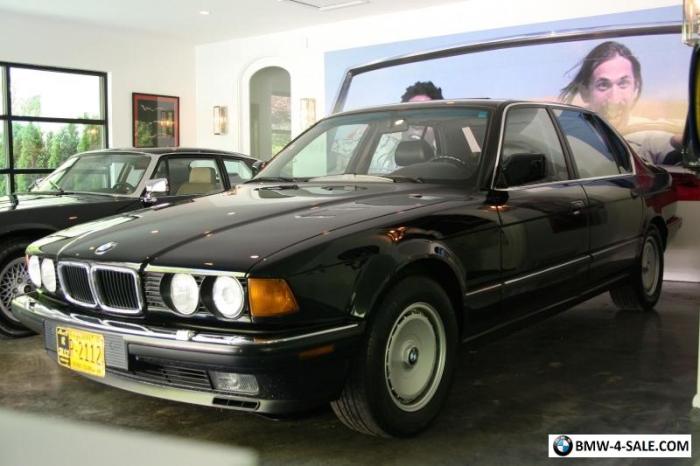
The 1988 BMW 7 Series, despite its age, was designed with safety in mind and is generally considered a reliable vehicle. However, as with any car of this era, certain issues and concerns should be considered.
Safety Features
The 1988 BMW 7 Series offered a range of safety features for its time. These included:
- Anti-lock Braking System (ABS):This feature was optional on the 7 Series and helped prevent wheel lock-up during braking, improving vehicle control in slippery conditions.
- Airbags:The 1988 7 Series was one of the first models to offer airbags as an option. These were only available for the driver, and passenger airbags were not yet standard in most vehicles.
- Seatbelts:The 7 Series came standard with lap and shoulder belts for all passengers. While these were considered basic safety features, they were important in preventing injuries during a collision.
- Body Structure:The 7 Series was built with a robust body structure designed to absorb impact energy in a collision, helping to protect occupants.
Reliability and Longevity
The 1988 BMW 7 Series, when properly maintained, is known for its reliability and longevity. Many examples of these vehicles are still on the road today, with some owners reporting exceeding 200,000 miles. However, due to its age, certain components may require more frequent attention and replacement.
Known Issues and Concerns
While generally reliable, the 1988 BMW 7 Series has some known issues and concerns. These include:
- Engine:The 3.4-liter and 3.5-liter inline-six engines are known for their durability, but they can be prone to issues with the valve stem seals, leading to oil consumption. Additionally, the timing chain can stretch over time, requiring replacement.
- Transmission:The automatic transmission, while generally robust, can experience problems with solenoids and seals, causing shifting issues. Regular maintenance is crucial to prevent these issues.
- Suspension:The suspension components, such as control arms, bushings, and shocks, can wear out over time, leading to a rough ride and handling issues. Replacement of these parts is common on older 7 Series models.
- Electrical System:The 1988 7 Series features a complex electrical system that can be prone to issues with wiring, sensors, and control modules. Diagnosing and repairing electrical problems can be challenging.
- Rust:Like many cars of its era, the 1988 7 Series can be susceptible to rust, particularly in areas with harsh weather conditions. Regular inspections and rust prevention treatments are essential to maintain the vehicle’s structural integrity.
Cultural Impact and Legacy
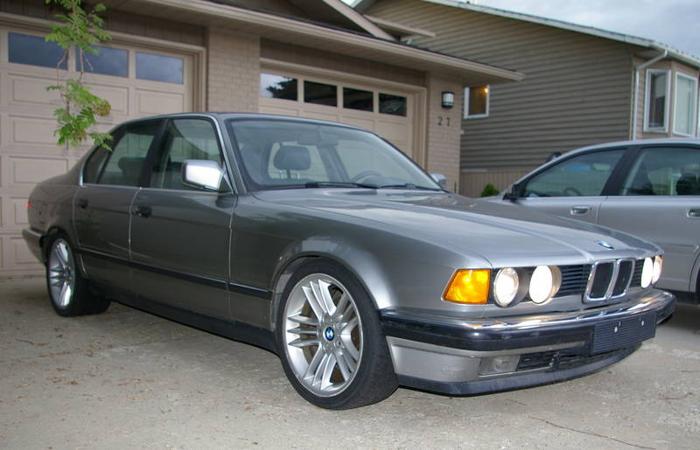
The 1988 BMW 7 Series was more than just a luxury car; it was a cultural touchstone that defined the era and left an indelible mark on the automotive landscape. It not only set new standards for luxury and technology but also profoundly influenced the future of BMW and the entire automotive industry.
Impact on the Automotive Industry
The 1988 7 Series was a watershed moment for BMW, marking a significant shift in its approach to luxury car design and engineering. It introduced groundbreaking features that became industry benchmarks and paved the way for future innovations. The car’s advanced technology, including the first-ever electronic stability control system, and its focus on driver-centric design influenced the development of future luxury cars from other manufacturers.
Collecting and Restoration

The 1988 BMW 7 Series, while not yet considered a classic in the same vein as its predecessors, is gaining traction among enthusiasts and collectors. Its sleek design, powerful engines, and advanced technology for its time make it an attractive proposition for those seeking a unique and luxurious driving experience.
Market Value and Collectability, 1988 BMW 7 Series
The market value of a 1988 7 Series varies significantly depending on its condition, mileage, and specific model. Well-maintained and low-mileage examples can fetch premium prices, while those needing restoration may be more affordable. The most sought-after models include the 735i and the high-performance 750iL.
The E32 generation, which includes the 1988 model year, is starting to see an increase in value, particularly for examples in exceptional condition.
Restoring and Maintaining a 1988 7 Series
Restoring and maintaining a 1988 7 Series requires a dedicated approach. The car’s advanced technology and complex systems can present unique challenges for both novice and experienced mechanics. A thorough inspection by a qualified BMW specialist is essential before purchasing any example.
Resources for Collectors and Enthusiasts
- BMW Clubs:Numerous BMW clubs around the world offer resources, forums, and events for enthusiasts. These clubs can provide valuable information on parts sourcing, technical advice, and restoration tips.
- Online Forums:Online forums dedicated to the E32 7 Series provide a platform for enthusiasts to connect, share information, and seek advice. These forums are excellent resources for finding parts, troubleshooting problems, and learning about the model’s history.
- Specialist Shops:Several specialist shops specialize in restoring and maintaining classic BMWs, including the E32 7 Series. These shops can offer expertise in sourcing parts, performing complex repairs, and ensuring the car is restored to its original condition.
Final Wrap-Up
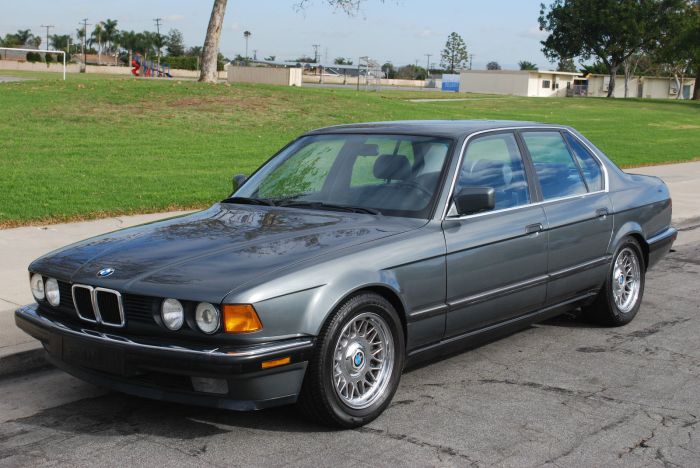
The 1988 BMW 7 Series stands as a testament to BMW’s commitment to innovation and luxury. It was a car that redefined expectations in its segment, influencing future generations of BMW vehicles and leaving an enduring mark on the automotive landscape.
Today, the 1988 7 Series continues to captivate enthusiasts, serving as a reminder of a bygone era when craftsmanship and performance were paramount.